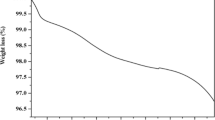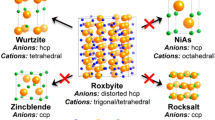Abstract
Nanoparticles of two molecule-based conductors, namely TTF·TCNQ and TTF[Ni(dmit)2]2, have been prepared in organic solution in the presence of ionic or nonionic species bearing a long-chain alkyl group, acting as growth-controlling agents. The size, morphology, and state of dispersion of the nanoparticles depended on the nature of the growth-controlling agent and the reaction temperature. In the presence of a long-chain alkyl-based ionic liquid at −50 °C, electron micrographs evidence that TTF·TCNQ nano-objects are frequently elongated, whereas TTF[Ni(dmit)2]2 nanoparticles are aggregated. In the presence of a neutral long-chain alkyl-based imine at room temperature, nanoparticles are spherical (mean diameter <20 nm) and well dispersed. Vibration spectra evidence that the amounts of charge transfer for TTF·TCNQ and TTF[Ni(dmit)2]2 as nano-objects are very similar to those for the same phases as bulk materials. According to the thermoanalytical investigations, the prepared nanoparticles are stable thermally up to approximately 200 °C, and their decomposition is generally a multi-step process. Their heat treatment results in various sulfur-containing volatiles (CS2, SO2, H2S); moreover, HCN is also detected in the case of nitrogen-containing molecules (TCNQ).













Similar content being viewed by others
References
Valade L, Tanaka H. Molecular inorganic conductors and superconductors. In: Bruce DW, O’Hare D, Walton RI, editors. Molecular materials. London: Wiley; 2010. p. 211–80.
Fraxedas J. Molecular organic materials—from molecules to crystalline solids. Cambridge: Cambridge University Press; 2006.
Cassoux P, Valade L. Molecular inorganic superconductors. In: Bruce DW, O’Hare D, editors. Inorganic materials. 2nd ed. Chichester: Wiley; 1996.
Savy JP, de Caro D, Faulmann C, Valade L, Almeida M, Koike T, Fujiwara H, Sugimoto T, Fraxedas J, Ondarçuhu T, Pasquier C. Nanowires of molecule-based charge-transfer salts. New J Chem. 2007;31:519–27.
Lv J, Liu H, Li Y. Self-assembly and properties of low-dimensional nanomaterials based on π-conjugated organic molecules. Pure Appl Chem. 2008;80:639–58.
Ren L, Xian X, Yan K, Fu L, Liu Y, Chen S, Liu Z. A general electrochemical strategy for synthesizing charge-transfer complex micro/nanowires. Adv Funct Mater. 2010;20:1209–23.
Jung YJ, Kim Y, Kim GT, Kang W, Noh DY. Electrochemical fabrication of (TMTSF)2X (X = PF6, BF4, ClO4) nanowires. J Nanosci Nanotechnol. 2012;12:5397–401.
Bhatt A, Mechler Á, Martin LL, Bond AM. Synthesis of Ag and Au nanostructures in an ionic liquid: thermodynamic and kinetic effects underlying nanoparticle, cluster and nanowire formation. J Mater Chem. 2007;17:2241–50.
de Caro D, Jacob K, Faulmann C, Legros J-P, Senocq F, Fraxedas J, Valade L. Ionic liquid-stabilized nanoparticles of charge transfer-based conductors. Synth Met. 2010;160:1223–7.
de Caro D, Jacob K, Hahioui H, Faulmann C, Valade L, Kadoya T, Mori T, Fraxedas J, Viau L. Nanoparticles of organic conductors: synthesis and application as electrode material in organic field effect transistors. New J Chem. 2011;35:1315–9.
de Caro D, Jacob K, Faulmann C, Valade L, Viau L. TTF[Ni(dmit)2]2: now as nanoparticles. C R Chim. 2012;15:950–4.
de Caro D, Valade L, Faulmann C, Jacob K, Van Dorsselaer D, Chtioui I, Salmon L, Sabbar A, El Hajjaji S, Pérez E, Franceschi S, Fraxedas J. Nanoparticles of molecule-based conductors. New J Chem. 2013;37:3331–6.
Gonfa G, Bustam SA, Man Z, Adbul Mutalib MI. Unique structure and solute-solvent interaction in imidazolium based ionic liquids: a review. Asian Trans Eng. 2011;1(05):24–34.
Philippot K, Chaudret B. Organometallic derived metals, colloids, and nanoparticles. In: Crabtree RH, Mingos MP, editors. Comprehensive organometallic chemistry III—from fundamentals to applications. Amsterdam: Elsevier; 2007. p. 71–99.
de Caro D, Souque M, Faulmann C, Coppel Y, Valade L, Fraxedas J, Vendier O, Courtade F. Colloidal solutions of organic conductive nanoparticles. Langmuir. 2013;29(28):8983–8.
de Caro D, Faulmann C, Valade L, Jacob K, Chtioui I, Foulal S, de Caro P, Bergez-Lacoste M, Fraxedas J, Ballesteros B, Brooks JS, Steven E, Winter LE. Four molecular superconductors isolated as nanoparticles. Eur J Inorg Chem. 2014;24:4010–6.
Wudl F. A new approach to the preparation of tetrathiafulvalenium salts. J Am Chem Soc. 1975;97(7):1962–3.
Steimecke G, Sieler HJ, Kirmse R, Hoyer E. First synthesis of complexes of C3S5 2−. Phosphorus Sulfur. 1979;7:49–55.
Bergez-Lacoste M, Thiebaud-Roux S, de Caro P, Fabre J.-F, Mouloungui Z. Dérivés du furfural pour une application biosolvants, Patent FR1351811, France; 2013.
Sun Y, Sheng P, Di C, Jiao F, Xu W, Qiu D, Zhu D. Organic thermoelectric materials and devices based on p- and n-Type poly(metal 1,1,2,2-ethenetetrathiolate)s. Adv Mater. 2012;24:932–7.
Chappell JS, Bloch AN, Bryden WA, Maxfield M, Poelher PO, Cowan DO. Degree of charge transfer in organic conductors by infrared absorption spectroscopy. J Am Chem Soc. 1981;103(9):2442–3.
Kuzmany H, Stolz HJ. Raman scattering of TTF-TCNQ and related compounds. J Phys C: Solid State Phys. 1977;10:2241–52.
De Caro D, Fraxedas J, Faulmann C, Malfant I, Milon J, Lamère JF, Collière V, Valade L. Metallic thin films of TTF[Ni(dmit)2]2 by electrodeposition on (001)-oriented silicon substrates. Adv Mater. 2004;16:835–8.
Savy JP, De Caro D, Valade L, Legros JP, Auban-Senzier P, Pasquier CR, Fraxedas J, Senocq F. Superconductivity in TTF[Ni(dmit)2]2 films. EPL. 2007;78:37005/1–5.
Liu G, Fang Q, Xu W, Chen H, Wang C. Vibration assignment of carbon–sulfur bond in 2-thione-1,3-dithiole-4,5-dithiolate derivatives. Spectrochim Acta A. 2004;60:541–50.
Pokhodnya KI, Faulmann C, Malfant I, Andreu-Solano R, Cassoux P, Mlayah A, Smirnov D, Léotin J. Infrared and Raman properties of [M(dmit)2] (M = Ni, Pd) based compounds. Synth Met. 1999;103:2016–9.
Bozio R, Zanon I, Girlando A, Pecile C. Vibrational spectroscopy of molecular constituents of one-dimensional organic conductors. Tetrathiofulvalene (TTF), TTF+, and (TTF+)2 dimer. J Chem Phys. 1979;71:2282–93.
Siedle AR. Metal complexes of tetrathiafulvalene and related compounds. In: Miller JS, editor. Extended linear chain compounds, vol. 2. New York: Plenum Press; 1982. p. 469–87.
Muraoka Y, Imajo S, Yamashita S, Akutsu H, Nakazawa Y. Thermal anomaly around the superconductive transition of κ-(BEDT-TTF)2Cu(NCS)2 with external pressure and magnetic field control. J Therm Anal Calorim. 2016;123:1891–7.
Ishikawa T, Yamashita S, Nakazawa Y, Kawamoto A, Oguni M. Calorimetric study of molecular superconductor κ-(BEDT-TTF)2Ag(CN)2H2O which contains water in the anion layers. J Therm Anal Calorim. 2008;92:435–8.
Bhattacharjee A, Roy D, Roy M. Thermal degradation of a molecular magnetic material: {N(n-C4H9)4[FeIIFeIII(C2O4)3]}∞. J Therm Anal Calorim. 2012;109:1423–7.
Acknowledgements
The authors would like to thank CNRST-Morocco for a grant (S. F.) and Ministère de l’Enseignement Supérieur et de la Recherche-France for a grant (I. C.). We would also like to thank CNRS-Toulouse and Université Paul Sabatier-Toulouse.
Author information
Authors and Affiliations
Corresponding author
Rights and permissions
About this article
Cite this article
Foulal, S., El Hajjaji, S., Trif, L. et al. Molecular conductors as nanoparticles in the presence of long-chain alkyl imidazolium salts or amphiphilic molecules. J Therm Anal Calorim 127, 1879–1888 (2017). https://doi.org/10.1007/s10973-016-5858-z
Received:
Accepted:
Published:
Issue Date:
DOI: https://doi.org/10.1007/s10973-016-5858-z




